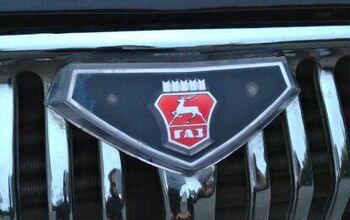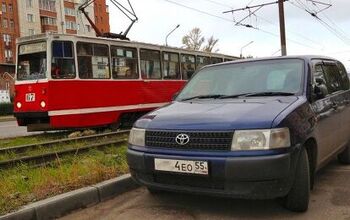Best Selling Cars Around The Globe – Trans Siberian Series Part 16: The Best-selling Cars in Mongolia
This is the final Mongolian post in our Trans-Siberian Series, exploring a very unique and surprising list of the best-selling models in the country. Next stop will be China! But first, a slice of modern Mongolian culture for you. As you will see below the Mercedes G-Class is at world-best levels in the Mongolian sales charts and has reached cult-level in the country. Proof: above is the music video for Mongolian R’n’b artist Tselmuun’s latest hit “Setgel”. From 2min49 in the video you can see a line of Mercedes G-Class behind the dancers, not one but 4 of them – so hot right now…
If you can’t wait for the next report, you can follow my trip in real time here, or check out 174 other car markets on my blog.
After chasing, following up and chasing again many actors of the Mongolian automotive industry, here it is in all its glory thanks to Toyota’s distributor in the country Khet Motors: the official Top 12 best-selling new cars in Mongolia over the first half of 2013. Yep that’s the most recent official data available for this country, but better this than nothing!
These 12 models added up to 1,568 sales over the Full Year 2012 and 913 over the first half of 2013, which can be extrapolated as approximately 40% increase of the overall Mongolian new car market year-on-year… Talk about explosive growth.
Observation in the streets of Ulaanbaatar didn’t lie: the Toyota Land Cruiser is well and truly king around here, selling 501 units over the Full Year 2012 and 375 so far in 2013. It’s hard to estimate the Land Cruiser’s overall market share but it should definitely be north of 20%. Kia Mongolia tells me a special order from the Ulaanbaatar police has pushed the Kia Rio up to 2nd place so far in 2013 with 97 sales, and this makes sense as I did not see any ‘private’ Rios the entire time I stayed there.
#2 in 2012, the Lexus LX570 is pushed down to a still incredible third position in 2013 so far thanks to 88 units sold above the Hyundai Tucson at 54 sales. But the most characteristic and unique element of the Mongolian new car market is found in 5th position: the Mercedes G-Class reaches its world-best ranking here thanks to 51 units sold and up from #7 in 2012! The G-Class is simply adored by Mongolian consumers and has reached cult-status, being included in numerous local music (Mongol pop or rap) videos.
It is a very interesting models ranking indeed for Mongolia, with many other high-end models ranking inside the Top 12 like the Toyota Land Cruiser Prado at Hyundai Sonata at Toyota Land Cruiser 70 at Ford Everest at #10 and Range Rover at This is typical of very ‘young’ new car markets where only the wealthiest have the money to afford to buy a new vehicle, and therefore go all out when they do. Given the very large majority of the Mongolian population can only afford to buy used Japanese imports, the Mongolian new car sales charts end up looking like they belong to a petrol-rich Middle-Eastern country…
Mongolia 6 months 2013 – best-selling models:
H1: First Half, FY: Full Year
PosModel2013 H12012 FYPos1Toyota Land Cruiser 20037550112Kia Rio97n/an/a3Lexus LX5708825824Hyundai Tucson5411755Mercedes G-Class517976Toyota Land Cruiser Prado488967Hyundai Sonata4611948Kia Sportage44n/an/a9Toyota Land Cruiser 7037139310Ford Everest27n/an/a11Range Rover25471112Hyundai Santa Fe21n/an/aNissan Patroln/a628Hyundai Accentn/a628Hyundai Elantran/a4810Nissan Patrol Y62n/a4711Source: Khet Motors
More by Matt Gasnier
Latest Car Reviews
Read moreLatest Product Reviews
Read moreRecent Comments
- Jalop1991 In a manner similar to PHEV being the correct answer, I declare RPVs to be the correct answer here.We're doing it with certain aircraft; why not with cars on the ground, using hardware and tools like Telsa's "FSD" or GM's "SuperCruise" as the base?Take the local Uber driver out of the car, and put him in a professional centralized environment from where he drives me around. The system and the individual car can have awareness as well as gates, but he's responsible for the driving.Put the tech into my car, and let me buy it as needed. I need someone else to drive me home; hit the button and voila, I've hired a driver for the moment. I don't want to drive 11 hours to my vacation spot; hire the remote pilot for that. When I get there, I have my car and he's still at his normal location, piloting cars for other people.The system would allow for driver rest period, like what's required for truckers, so I might end up with multiple people driving me to the coast. I don't care. And they don't have to be physically with me, therefore they can be way cheaper.Charge taxi-type per-mile rates. For long drives, offer per-trip rates. Offer subscriptions, including miles/hours. Whatever.(And for grins, dress the remote pilots all as Johnnie.)Start this out with big rigs. Take the trucker away from the long haul driving, and let him be there for emergencies and the short haul parts of the trip.And in a manner similar to PHEVs being discredited, I fully expect to be razzed for this brilliant idea (not unlike how Alan Kay wasn't recognized until many many years later for his Dynabook vision).
- B-BodyBuick84 Not afraid of AV's as I highly doubt they will ever be %100 viable for our roads. Stop-and-go downtown city or rush hour highway traffic? I can see that, but otherwise there's simply too many variables. Bad weather conditions, faded road lines or markings, reflective surfaces with glare, etc. There's also the issue of cultural norms. About a decade ago there was actually an online test called 'The Morality Machine' one could do online where you were in control of an AV and choose what action to take when a crash was inevitable. I think something like 2.5 million people across the world participated? For example, do you hit and most likely kill the elderly couple strolling across the crosswalk or crash the vehicle into a cement barrier and almost certainly cause the death of the vehicle occupants? What if it's a parent and child? In N. America 98% of people choose to hit the elderly couple and save themselves while in Asia, the exact opposite happened where 98% choose to hit the parent and child. Why? Cultural differences. Asia puts a lot of emphasis on respecting their elderly while N. America has a culture of 'save/ protect the children'. Are these AV's going to respect that culture? Is a VW Jetta or Buick Envision AV going to have different programming depending on whether it's sold in Canada or Taiwan? how's that going to effect legislation and legal battles when a crash inevitibly does happen? These are the true barriers to mass AV adoption, and in the 10 years since that test came out, there has been zero answers or progress on this matter. So no, I'm not afraid of AV's simply because with the exception of a few specific situations, most avenues are going to prove to be a dead-end for automakers.
- Mike Bradley Autonomous cars were developed in Silicon Valley. For new products there, the standard business plan is to put a barely-functioning product on the market right away and wait for the early-adopter customers to find the flaws. That's exactly what's happened. Detroit's plan is pretty much the opposite, but Detroit isn't developing this product. That's why dealers, for instance, haven't been trained in the cars.
- Dartman https://apnews.com/article/artificial-intelligence-fighter-jets-air-force-6a1100c96a73ca9b7f41cbd6a2753fdaAutonomous/Ai is here now. The question is implementation and acceptance.
- FreedMike If Dodge were smart - and I don't think they are - they'd spend their money refreshing and reworking the Durango (which I think is entering model year 3,221), versus going down the same "stuff 'em full of motor and give 'em cool new paint options" path. That's the approach they used with the Charger and Challenger, and both those models are dead. The Durango is still a strong product in a strong market; why not keep it fresher?
























































Comments
Join the conversation
If I were a "big 3" executive or even a German auto emperor reading this, I'd hurry up to get my high-margin 4x4 product line to Mongolia asap. Mongolia is a growing market, and en route to do so for quite some time. Now is the opportunity to define what is desirable, and it seems that Japanese fare is doing best. Apart from the G, that is - one ancient German taking over for ancient Ukrainians...
Brown is a nice color for the Venza